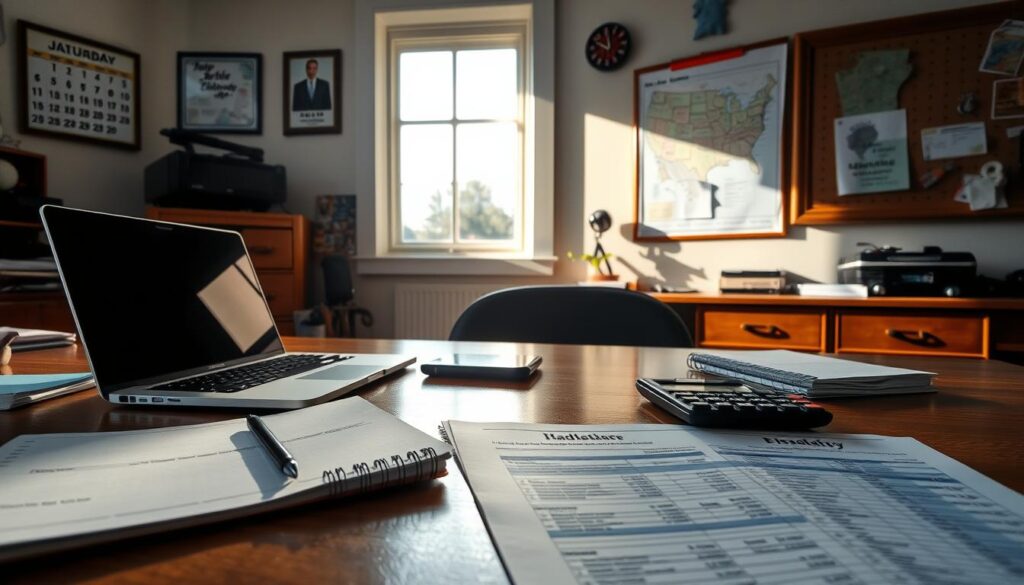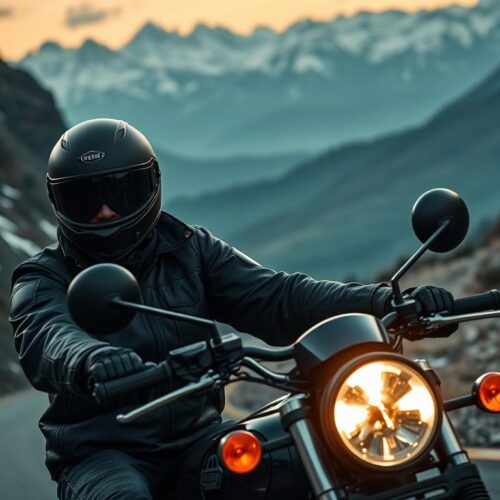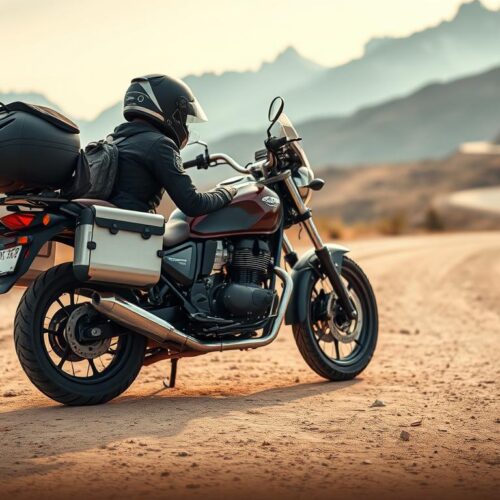Ready to feel the freedom of the open road on a motorcycle? This guide has everything you need to plan the perfect motorcycle road trip. You’ll learn how to pick your destination, manage your budget, and more. We’ll make every step clear and easy to follow. This way, you can focus on having an exciting and unforgettable journey.
Introduction to Motorcycle Road Trip Planning
Planning a motorcycle road trip is exciting. It’s a chance to feel adventure on the open road. Make sure to enjoy the journey, not just the destination. This lets you fully experience what traveling on a motorcycle offers.
Getting ready for your trip means looking at many details. You need to pick your path, figure out money for gas and places to stay, and be safe while riding. Each part is crucial to make your trip amazing. Good planning helps you make great memories, see beautiful places, and find hidden spots.
Motorcycle trips bring a special feeling of freedom and discovery. Pay attention to every part of your trip. This turns your ride into more than just getting from one place to another. It becomes a travel adventure that teaches you about life.
Choosing Your Destination
Picking the right spot for your motorcycle trip is key to an awesome adventure. Things like how long you’ll travel, the views you’ll see, and what you love matter a lot. If you’re into nature, think about places with amazing parks or mountains. For those who love history, choose routes with interesting historical sites.
Your trip’s vibe is big too. Are you looking for thrill or calm? Think about what you really want from your trip. Asking yourself questions like how long you’ll be on the road and what cool things you want to see is crucial. This helps you plan well and pick a place that fits your dreams.
Use the table below to compare various types of destinations based on different themes:
| Destination Type | Key Attractions | Best Travel Season | Travel Duration |
|---|---|---|---|
| National Parks | Scenic vistas, wildlife, hiking trails | Spring/Fall | 1 week |
| Coastal Routes | Beaches, lighthouses, fresh seafood | Summer | 5-10 days |
| Historical Sites | Museums, battlegrounds, heritage sites | Year-round | 3-7 days |
| Mountain Passes | Twisting roads, panoramic views | Summer | 4-8 days |
In the end, picking where to go on your motorcycle trip means thinking about what speaks to you. With thoughtful planning, you’re set for a trip that’s both enriching and unforgettable.
Selecting the Right Motorcycle
Choosing the right motorcycle for a road trip is crucial for fun. Think about how long you’ll travel and the roads you’ll take. These will greatly affect your motorcycle choice.
A comfortable motorcycle is key for long journeys. Look at seat height and handlebar position. Check the engine size too. Big engines are great for highways, and small ones save gas in the city.
Fuel efficiency is important for long trips without many gas stops. Choose a bike that’s powerful but also saves on gas. This helps you travel far without stopping a lot.
Having enough storage is vital. It makes travel easier and more comfortable. Pick bikes with saddlebags or add storage options to carry all your stuff.
Finally, pick a motorcycle in good shape. Check its maintenance history. A well-maintained bike performs better and gives you peace of mind during your trip.

Preparing Your Motorcycle for the Journey
Before you hit the road, getting your motorcycle ready is key. A bike in top shape ensures your safety and improves the ride. This lets you enjoy your journey without worrying about your bike breaking down.
Here are the essential checks:
- Fluid Levels: Make sure oil, coolant, brake, and transmission fluids are full.
- Tire Condition: Look at tire tread and pressure and check for wear or damage.
- Brakes: Test front and rear brakes and the brake fluid level.
- Lights: Make sure all lights work well.
If checking your bike sounds hard, take it to a pro. They can spot problems before they ruin your trip. It’s a smart move.
Also, bring a repair kit for the road. You should have:
- Spare tire repair tools
- Adjustable wrenches
- Zip ties and duct tape
- First aid supplies
Getting your motorcycle ready boosts your confidence. It also makes your ride safer and smoother. So, focus on these important steps for a great trip.
| Motorcycle Check | Importance |
|---|---|
| Fluid Levels | Prevents engine and brake failure |
| Tire Condition | Affects grip and handling |
| Brakes | Crucial for rider safety |
| Lights | Ensures visibility and signaling |
Planning Your Itinerary
Planning your itinerary well means you get the most from your motorcycle trip. First, sketch out daily routes and guess how long rides will take. Use apps like Google Maps or Roadtrippers to see your path and spots to check out.
Make sure to include time for meals and breaks. This keeps you energized and makes the trip better. Add in beautiful sights, fun places to visit, and good spots to eat to make your adventure richer. A solid plan has order but also lets you explore if you find something cool or need to change plans due to the weather or traffic.
Here’s a sample itinerary structure:
| Day | Destination | Distance (miles) | Estimated Travel Time | Planned Stops |
|---|---|---|---|---|
| 1 | City A to City B | 150 | 3 hours | Lunch at Joe’s Diner, Scenic Viewpoint |
| 2 | City B to City C | 200 | 4 hours | Rest Stop, Gas Station |
| 3 | City C to City D | 180 | 3.5 hours | Visit National Park, Dinner at Local Pub |
Keeping your plans both organized and flexible is key. Enjoy your ride and the sense of freedom the open road brings.
Budgeting for Your Motorcycle Trip
Making a budget for your motorcycle trip is key to a great adventure. Start by listing must-have expenses. These usually include fuel, places to stay, food, and fees for places you want to see. Knowing these costs helps you set a budget that covers everything, even surprises.
For fuel costs, think about your trip distance and how much gas your bike uses. Look up gas prices along your way. Your choice of where to stay, like camping or motels, will affect your budget a lot. Planning meals ahead can save money and keep you going. For money-saving tips, check out this resource.
Make a budget that suits your style and likes. Changing where you stay or how you handle meals adds flexibility but keeps you on budget. Watch your spending during your trip to avoid going over budget. This way, you can fully enjoy your journey.

Safety and Gear Considerations
Going on a motorcycle trip means safety first. It’s crucial to wear the right safety gear. This gear includes a helmet that fits well, jackets that protect, gloves, and strong boots. Every piece helps keep you safe and comfy on long rides.
Knowing how to ride safely makes your trip better. Keep a safe gap between you and other vehicles. This gives you time to stop suddenly if needed. Pay attention to what’s happening around you. Watch the traffic and road conditions to stay safe.
Here are some crucial items to consider when selecting your motorcycle safety gear:
- Helmet: A DOT-approved helmet can significantly reduce the risk of head injuries.
- Protective Jackets: Look for jackets made with abrasion-resistant materials and armor at critical impact points.
- Gloves: Durable gloves offer grip and protection, improving the control of your motorcycle.
- Boots: Select boots designed for motorcycle use, providing ankle support and protection.
Also, know the traffic laws in the area. Gear and safety rules can vary by state. Follow these rules and be proactive about safety. Doing so will set you up for a great and safe trip on the road.
Accommodations and Stops
Planning your stay ahead of time makes your motorcycle trip better. It ensures you have a comfy place to rest when needed. Look into hotels, motels, and campgrounds on your path. Checking these out adds safety and might lead to cool experiences.
Think about where you’ll stop for food, gas, and to look around. Having a break schedule helps keep you energized and focused. Taking time to stretch and relax helps fight off tiredness and makes the trip fun.
| Type of Accommodation | Benefits | Considerations |
|---|---|---|
| Hotels | Comfortable and usually equipped with amenities. | May be pricier; ensure secure parking for your motorcycle. |
| Motels | Convenient and often located near highways. | Fewer amenities compared to hotels, but often more budget-friendly. |
| Campgrounds | Affordable and offer a unique outdoor experience. | Weather-dependent and may require extra gear for comfort. |
Look at local forums or apps for tips on the best stops. With good planning, you’ll enjoy your road time fully. You’ll get to explore all the fun your motorcycle trip can bring.
Packing for Your Motorcycle Road Trip
Packing for a motorcycle trip tests how well you can organize. You have little space on a bike, so you need to think about what to take. You must pick items that are both useful and able to serve many purposes.
Your packing list should include:
- Clothing for all types of weather, like layers that breathe and keep out rain.
- Gear for a comfy ride such as gloves, boots, and a helmet that fits right.
- Essentials like toothpaste and any medicines.
- Outdoor living stuff if you’re camping, like a compact tent and sleeping bag.
- If you’re cooking, bring stuff like a small stove.
Don’t forget things for your bike. Make sure to have tools for fixing flats, a repair kit, and a first-aid kit. These could save your trip or even your life.
Try to pack light when you’re getting ready. A lighter bike means better control and fun on the road. Keep checking your list to ensure you have everything important without extra stuff you don’t need.
Managing Your Time on the Road
Managing your time well on road trips is crucial for a great experience. Setting up a daily plan for motorcycle travel helps you get to places on time. It lets you enjoy stops without feeling hurried. It’s about making memories without the rush.
It’s wise to plan breaks. Taking regular stops fights off tiredness. You get to rest and power up again. You could use a timer or phone alerts to keep on track.
It’s also fun to be a bit spontaneous on your trips. Make sure there’s space for unplanned adventures. When something unexpected pops up, see how it fits with your plan. Being flexible can make your journey truly memorable.
Reflecting on Your Journey
After your motorcycle trip, take a moment to reflect. This helps you think about what you’ve learned. Writing in a travel journal is a good way to remember your adventures and challenges.
Think about what went well and what could be better next time. Reflecting helps you see the beauty of your ride. It also lets you see how you’ve grown from overcoming obstacles.
Taking photos of your motorcycle adventure is important, too. These pictures remind you of your journey every time you see them. Your reflections and journaling, along with these photos, create a story of your trip.




